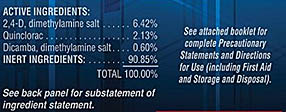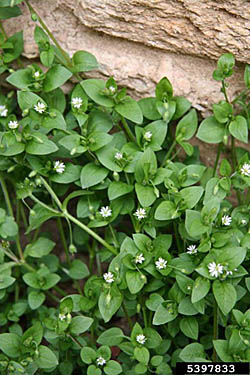Five Things to Know About Selective Weed Killers
By Gil Medeiros, Fairfax Master Gardener
 To benefit from the advice I offer below, you must routinely read the label of any herbicide product you are about to use. If you need a magnifier to read the small print, get one. You want to make sure you use these products in ways that are safe for you, your lawn and the environment. These products are gentle on the environment when used according to the directions.
To benefit from the advice I offer below, you must routinely read the label of any herbicide product you are about to use. If you need a magnifier to read the small print, get one. You want to make sure you use these products in ways that are safe for you, your lawn and the environment. These products are gentle on the environment when used according to the directions.

Common chickweed
Common chickweed is controlled by mecoprop and MCPA.
For all the similarity among these five chemical compounds, they affect some plants more than others. For example, triclopyr has a greater effect than the others on woody plants. It is also the safest to use around conifers. Dicamba works well against ground ivy but not against plantains. Mecoprop and MCPA are good at controlling chickweed, which has been at epidemic levels here this spring. That is why the chemicals are almost always used in various combined formulations on home lawns.
Some Common Selective Post-Emergent Weed Killer Products and Their Active Ingredients
Trimec: 2,4-D, dicamba, mecoprop
Weed B Gon: 2,4-D, dicamba, mecoprop
Spectracide Weed Stop: 2,4-D, dicamba, mecoprop
Speed Zone: 2,4-D, dicamba, mecoprop (also contains carfentrazone)
Bonide Weed Beater Plus: 2,4-D, mecoprop (also contains quinclorac to control crabgrass)
Weed B Gon Chickweed, Clover, and Oxalis Killer: triclopyr
Bonide Chickweed,Clover and Oxalis Weed Killer: dicamba, MCPA, triclopyr
Scotts Turfbuilder Weed and Feed: 2,4-D, mecoprop (also contains fertilizer)
Listing of product names does not constitute an endorsement by FCMGA or the Virginia Cooperative Extension.
Some Common Selective Post-Emergent Weed Killer Products and Their Active Ingredients
Trimec: 2,4-D, dicamba, mecoprop
Weed B Gon: 2,4-D, dicamba, mecoprop
Spectracide Weed Stop: 2,4-D, dicamba, mecoprop
Speed Zone: 2,4-D, dicamba, mecoprop (also contains carfentrazone)
Bonide Weed Beater Plus: 2,4-D, mecoprop (also contains quinclorac to control crabgrass)
Weed B Gon Chickweed, Clover, and Oxalis Killer: triclopyr
Bonide Chickweed,Clover and Oxalis Weed Killer: dicamba, MCPA, triclopyr
Scotts Turfbuilder Weed and Feed: 2,4-D, mecoprop (also contains fertilizer)
Listing of product names does not constitute an endorsement by FCMGA or the Virginia Cooperative Extension.
Because these chemicals also have different physical and chemical properties, they can affect surrounding plants and the environment in different ways. Here are five things you should know before you use any product that contains one or more of these active ingredients:
- Do not use these products on a hot day, particularly products containing 2,4-D.
It’s easy to understand why you shouldn’t use herbicides on windy days; you can actually see wind gusts carrying the product away from its target. But 2,4-D requires an additional precaution. Don’t use it on hot days because it may evaporate from leaf surfaces. You will not be able to see this phenomenon, but susceptible plants are endangered just the same. The invisible vapors moved by air currents on a hot day may sicken nearby plants, such as your favorite roses or heirloom tomatoes.In recent years chemists have mitigated this problem by providing 2,4-D in less volatile forms. Nevertheless, pay close attention to label instructions. They usually caution against applying the product on days when temperatures reach or exceed 85 to 90 degrees. So, for example, if it is 70 degrees in the morning, but the forecast calls for 85 degrees later, do not use the product that day.
- All pose a threat of eye and skin irritation.
These compounds are not likely to make you sick unless you are extremely careless. They all have low toxicity to mammals and most other organisms (except 2,4-D, which is moderately toxic). However, be very careful to keep these chemicals off your skin. To prevent irritation, wear long pants, socks, shoes and a long-sleeved shirt when you apply them. Nitrile-rubber gloves are not a bad idea either. Don’t rub your eyes while using this stuff. Read and follow the directions on the container. - Dicamba can be absorbed through tree and shrub roots and cause unintended damage.
All of these chemicals can be absorbed through plant roots, but most of them degrade quickly in soil and stay where they are applied. Therefore, they are not a problem for tree and shrub roots. Dicamba is the exception. It has more residual activity and mobility in the soil than the others, so trees and shrubs can suffer if their roots absorb the chemical.When I am using a product containing dicamba, I treat each weed individually, rather than spray the product generally on my lawn. This approach has kept my trees and shrubs safe.
- Never apply one of these products when your cool-season lawn is stressed by heat or drought.
Spring or fall is the best time to apply these products, when the lawn and weeds are growing and healthy and soil moisture is likely higher. Stressed turfgrass may die from exposure to these chemicals — a coup de gras, so to speak, to grass plants that are already in trouble. According to Virginia Tech weed expert Dr. Shawn Askew, “Triclopyr hammers blue grass in the summer.” Heed his warning. - Ready-to- use (RTU) products have significant disadvantages compared to the concentrates.
Both Askew and Dr. Mike Goatley, Virginia Tech turfgrass expert, advise against using RTU products.
RTU products are generally sold in either small hand-sprayers or tank-sprayers. Manufacturers play it safe with RTU products; they want to make it difficult for you to spray too much product and kill the grass. (Who among us has never said, “If a little is good, a lot is better?”) RTU products are so dilute as sold, you will have to make at least two spray applications to achieve satisfactory control.
A second disadvantage is that RTU products have a poor shelf-life compared to concentrates. Any leftovers you keep for use next year will be less effective.Unless you are unable to comprehend mixing instructions (for example, use 1 ounce of product per gallon of spray), buy these products in concentrated form, and mix them yourself. Dedicate a sprayer of some sort for use exclusively with these products. Do not, for example, use the same sprayer for both lawn herbicide and rose fungicide. A little contamination can be a big problem.
The Virginia Pest Management Guide even provides “professional equivalency” formulas that allow you to use the concentrations that professional applicators use.
References
Training sessions given by Dr. Shawn Askew, Extension Specialist and Associate Professor, Virginia Tech, and Dr. Mike Goatley, Jr., Professor, Virginia Tech
Pest Management Guide: Home Grounds and Animals Section 5, Lawn 2016, Virginia Cooperative Extension
Weed Control in Home Lawns, Rutgers University Extension, Fact Sheet FS119
Weed Control for Kentucky Home Lawns University of Kentucky Cooperative Extension Service, Publication Number AGR-208
Bonide Weed Control Products
Pesticide Properties Database University of Herfordshire, UK